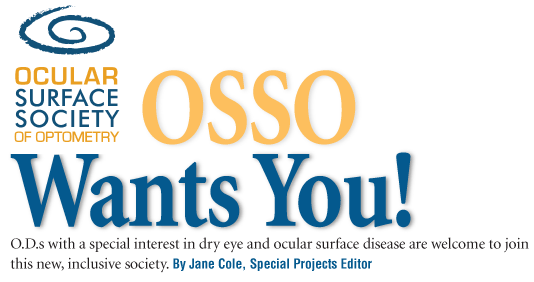
Birmingham,
What Dr. Schaeffer and a newly formed executive committee didnt know was how overwhelmingly positive a response they would receive when they first reached out to prospective charter members of this new group, which is officially titled the Ocular Surface Society of Optometry (OSSO).
After the group sent an e-mail inviting 75 renowned leaders in OSD and dry eye to become charter members, the executive committee received a resounding yes from 70 O.D.s within just 48 hours.
That was one of the proudest moments of this endeavor, Dr. Schaeffer says. It shows we have a real need and also that we have a great profession.
Now officially formed, OSSO is encouraging eye-care professionals to join their inclusive group to share ideas and obtain the latest information on these important conditions that optometrists routinely encounter in their practices.
While a few ocular surface disease organizations do already exist, these are primarily research-based. For the average optometrist, they need information to better manage these patients, says OSSO Vice President Lyndon Jones, Professor at the
On an average day, optometrists frequently encounter dry eye patientswhether these O.D.s specialize in contact lenses or are dealing with refraction patients, he adds. It is hard for many optom-etrists to know exactly where to get information on dry eye and ocular surface disease. Whether its a mild and relatively easily managed condition, such as minor lid disease, or a severe condition that requires anti-inflammatory drugs or steroids for treatment, OSSO hopes to be the premier resource for OSD and dry eye for practicing clinicians, Dr. Jones says.
The societys goal is to bridge the gap that currently exists between clinicians and the latest information and research on OSD and dry eye, says Kelly Nichols, O.D., M.P.H., Ph.D., associate professor at
OSSO will be launching several initiatives, programs and resources for its general membership. These include the development of an OSD track featuring well known and respected optometric leaders at every major meeting, dry eye and OSD papers written by the executive board and charter members in optometric journals, and a Web site (www.ossopt.com). The Web site will offer information on practice management, treatment, case studies and the latest innovations and technologies from both industry and experts in the profession.
The Web site will also include a blog and chat room where optometrists can present cases and learn from other unique cases presented by their peers.
One of the difficulties in dry eye clinical research is that there are not many approved therapies. A lot of clinicians are trying new methods that may become the basis of clinical studies, says Dr. Nichols.
Information sharing will provide a valuable resource for O.D.s. A member can come in and ask I have this patientwhat would you do? says Dr. Jones.
Other subspecialty topics will be added in the future, including contact lenses; new products, such as scleral and hybrid lenses; and new treatment strategies for diseases, such as graft vs. host disease.
Ocular surface diseases are the most common diseases optometrists will see now and in the next few decades, says
It is great to have an organization where doctors with interest in the medical management of corneal and ocular surface disease conditions can come together and share insights, treatment protocols, difficult cases and continue to learn and advance the profession in this very common area of pathology, he says. The camaraderie and opportunity to quickly contact colleagues with questions and ideas is very valuable. The opportunity to expand the collective knowledge of this group, through publications, research and educational opportunities, will benefit each of our practices, and most importantly, our patients.
Wanted: Optometric practitioners with a unique interest in dry eye and disorders of the ocular surface to join a new, inclusive group. If that sounds like your calling, the Ocular Surface Society of Optometry (OSSO) wants to hear from you.
OSSO Membership Drive
In order to join OSSO, you must have an O.D. degree from an accredited school or college of optometry, and you must complete an application (available online at www.ossopt.com).
Membership is $54 annually. Students, scientists and other physicians with a particular interest in dry eye and/or ocular surface disease are also welcome to become special class members of the OSSO. All members must be reputable individuals in good standing within the profession and community.
For more information on how to join OSSO, contact Dr. Katherine Mastrota at katherinemastrota@msn.com or Dr. Paul Karpecki at paul@karpecki.com.

